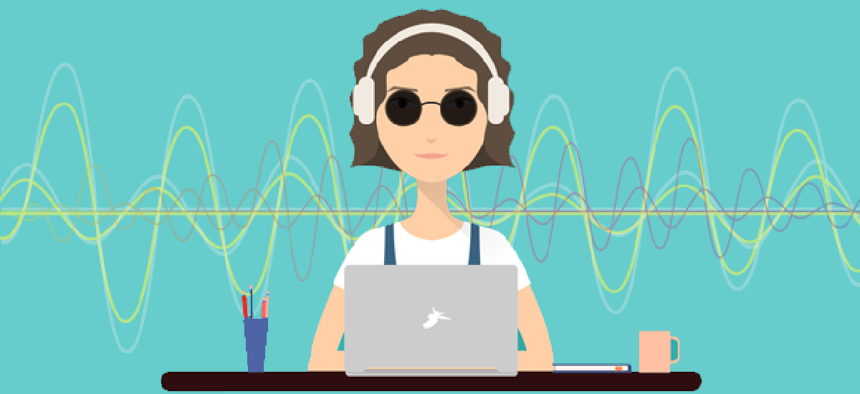Making graphics accessible to the visually impaired

New tools are making it easier for agencies to comply with content accessibility requirements.
Keeping up with her peers can sometimes be a challenge for Amy Bower, a senior scientist at the Woods Hole Oceanographic Institution who is legally blind. To understand the graphs she works with on a constant basis, Bower has relied largely on the assistance of a sighted person as her own vision has diminished over the past two decades.
“You’re just a little behind the eight ball the whole time, scrambling to try to get the same access to the information,” Bower said.
But she’s been beta testing the SAS Graphics Accelerator, a new web browser extension that is helping her regain independence at work. The tool monitors graphs in webpages, and when it finds one created with another SAS solution, it alerts a vision-impaired user via an earcon, a piano sound in this case. Users can then hear a description of the graph to find out basic information, such as what type of graph it is and its title.
Users can also drill down into the graph and its individual data points. For instance, the accelerator represents information on the Y axis of a graph with different sounds, so data points that are low on the axis have a low pitch. The X axis is mapped to a computer’s left and right speakers, so that data points on the left make a sound through the left speaker, while those on the right come through the right speaker.
“The ability to both quickly view the gist of a graphic and then also explore it data point by data point is really valuable, and to be able to do it all independently, I cannot tell you how welcome that is,” Bower said.
Ed Summers, senior manager of accessibility and applied assistive technology at SAS, can relate. Also blind, Summers found that traditional approaches -- essentially turning digital graph content into a physical format similar to Braille -- wasn’t enough.
Announced in late February, the accelerator works on Google Chrome (use with Mozilla Firefox is pending) and offers two levels of access: a text description or a text description plus interactive sonification. It supports eight types of graphs: Bar charts, time series plots, heat maps, line charts, scatter plots and histograms can be used with sound, while pie charts and ball plots work only with text.
The accelerator’s release comes almost two months after updated requirements for information and communication technology were made to Section 508 of the Rehabilitation Act. Specifically, the updates replace the focus on products with a focus on functions, according to the Partnership on Employment and Accessible Technology.To that end, technology covered by Section 508 now must conform to Web Content Accessibility Guidelines 2.0 Level A and Level AA Success Criteria and Conformance Requirements.
“All types of public-facing content and non-public-facing content that communicates agency official business have to be accessible,” according to PEAT.
That’s a trend that Tableau Software officials were already seeing in government. As a result, its Tableau 10.2 platform, released in March, added accessibility features in addition to capabilities such as advanced mapping, improved data preparation and IT governance.
“Starting in 10.2, an author of a visualization or a dashboard in Tableau can create their content and publish it with our server or online platform in such a way that that content meets the WCAG 2.0-level AA requirements,” said Kyle Gupton, director of engineering at Tableau.
For instance, Tableau defaults to text and background colors that meet the guidelines for contrast ratios that make it easier for people with visual impairments to see graphics. When a Tableau graph is published, the information is automatically compatible with assistive technologies and allows keyboard access to features like manipulating filters. It also lets screen-reader software get at the underlying data from a visualization in a textual format.
“Accessibility is a design decision. When you’re designing content, you do need to design it specifically for accessibility,” Gupton said.
Assistive technologies are under development at a variety of places. Purdue University researchers, for example, are creating software for a “haptic device” that lets visually impaired people view scientific images using a special joystick. As the user moves the cursor on the screen, the joystick uses force feedback, vibrations and sound cues to relay information about the object’s size, shape, texture and color, according to Phys Org.
More than a decade ago at NASA, Wanda Diaz-Merced, a visually impaired intern used sonification to study cataclysmic stars by turning data into sound using pitch, duration and other properties. That effort earned the University of Glasgow student a European Scholarship for Students with Disabilities from Google. Now a sonic astrophysicist, Merced described how she uses her ears not only to detect patterns in stellar radio data, but also uncover connections obscured by graphs and visual representation in a 2016 TED talk.
Additionally, several agencies collaborated to produce a guide to improving the accessibility to social media for public service. The toolkit includes tips such as including closed-captioning on videos posted to Facebook and adding descriptive captions to photos on Twitter.
"With 20 percent of the population estimated to have a disability, government agencies have an obligation to ensure that their messages, services and products are as inclusive as possible," according to a DigitalGov blog post.





